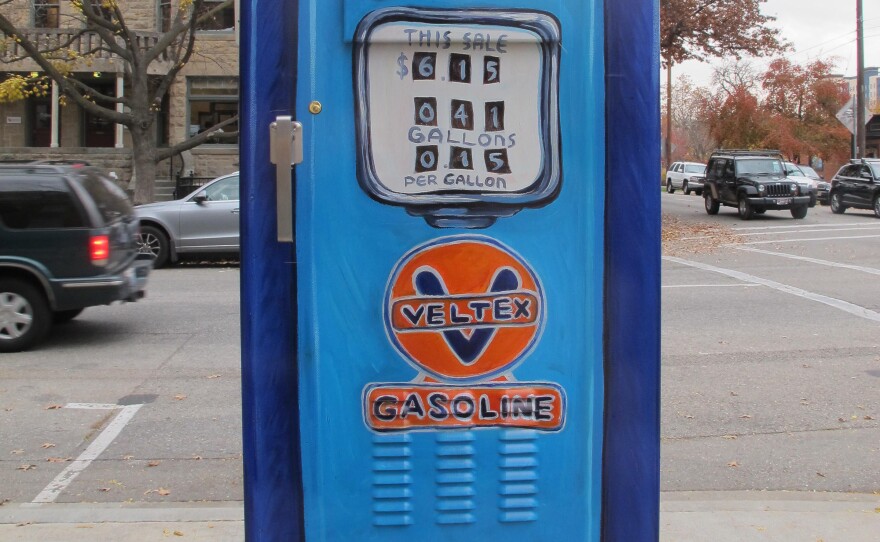Artist Pat Kilby is an oil painter.
“And I like to work in bright colors and kind of quirky perspective, little bit cartoonish I guess some people say,” says Kilby.
And he often would drive home on Fifth Street in downtown Boise and see the plain, white traffic box that controls the streetlight.
“I would pass the Veltex building. And it occurred to me one day that that box had to be a gas pump,” Kilby says.
The Veltex building used to be a gas station. And when it was turned into a mixed-use building, the old Veltex sign was left behind, a little bit of history in the downtown core. So when Kilby was picked for Boise’s Public Art Program, where artists design cover art for traffic boxes, he offered to paint a picture of a bright, colorful Veltex gas pump.
The idea was perfect, says Karl LeClair, Public Art Program Manager at Boise’s Arts and History Department. In fact, as part of their traffic box art program, each of the white boxes is matched up with an artist who is encouraged to find a creative connection to that spot in the city.
“We try to be thoughtful about where we’re placing artists and what the artwork will look like and how it will respond to its location,” says LeClair.
The program began in 2009, when there was a push to beautify the city starting with downtown. The traffic boxes that control the streetlights were a challenge and the Downtown Boise Association, Capital City Development Corporation and the city started looking for a way to dress them up. So they put out a call to emerging Idaho artists who, once chosen, get to create a picture to cover the box, like this one by artist Jill AnnieMargaret.
“This box is called the Haiku for Capitol Park. So here, Jill is responding to the proximity to the park. So she’s interested in some of the wildlife you may encounter, there’s a number of bird species, some dogs of course,” says LeClair.
And a Haiku that runs around the four sides of the box.

The original etching the artist made was digitized and fabricated onto a vinyl sheet that’s wrapped around the traffic box.
And, as an added bonus, putting the vinyl covers with the artwork on the boxes tends to discourage graffiti.
"We found that it’s fairly simple to wash off or remove stickers or marker tags or spray paint. The vinyl creates a slick surface that is pretty easily cleanable.”
When the program began, the vinyl wraps were given a five-year life span and now in the 8th year, they continue to outperform expectations.
LeClair says the 167 boxes that have been wrapped so far feature a wide variety of styles of artwork.
“From photography, printmaking, painting, drawing, even photographs, sculpture works, we have some comic-related boxes now. There’s a really great diversity in the vibrancy of the different media and different artists that are working here,” LeClair says.

The artists earn a $1,000 commission and get to keep ownership and copyright of the work. It costs another $1,000 to make the vinyl wraps. CCDC, the city’s Percent for Art Fund and the Neighborhood Investment Program all help pay for the boxes and the city takes care of maintenance costs. The partners form a committee, which picks the artists from an open call made each year.
Artist Pat Kilby says the first box he designed really helped kick-start his career
“I feel like it really legitimized me as an artist. I had people who would say, “Hey, wait that painting, I see your painting and did you do that box down on 9th and Idaho?” And it has come up dozens of times since,” says Kilby.
After completing two boxes in Boise, he’s been in several shows, created two traffic boxes in Ketchum and his work will be featured in the newly-renovated Idaho Historical Museum when it reopens next year.
Karl LeClair says people love the traffic boxes and they create a great addition to the fabric of the city.
“People find ones that they really are attached to, ones that are in their neighborhood. We find a real pride and ownership of the boxes, the response has been overwhelmingly in support of the program,” says LeClair.
This year, the program wrapped 23 traffic boxes around Boise. Next year, artists will wrap boxes around 30th street, as well as River and Myrtle. Art boxes can also be found around the state including Meridian, Moscow and Nampa.
This story is our latest installment in our “Wanna Know Idaho” series and came from Teri Weisensel who wanted to know, "What's the deal with the public art on the boxes around Boise? Who does them? Why? When did it start?" Have a question you've been curious about? Submit your question below!
_
Find Samantha Wright on Twitter @samwrightradio
Copyright 2017 Boise State Public Radio












